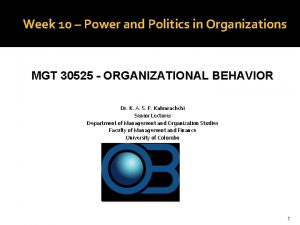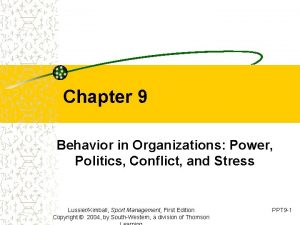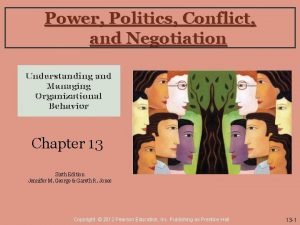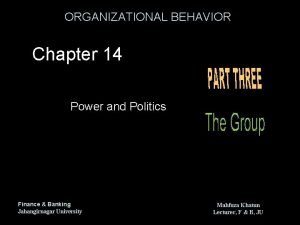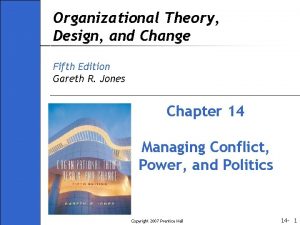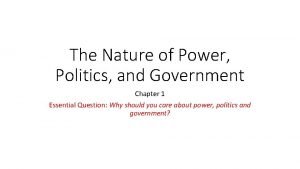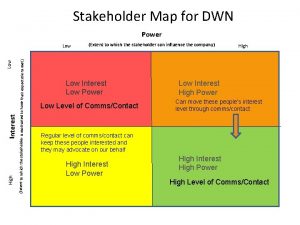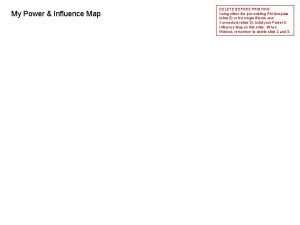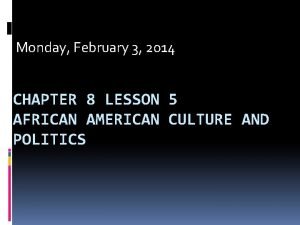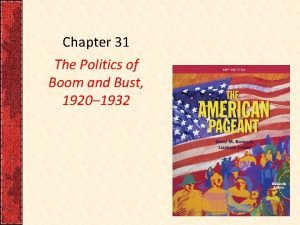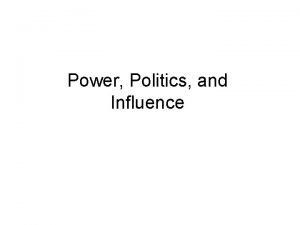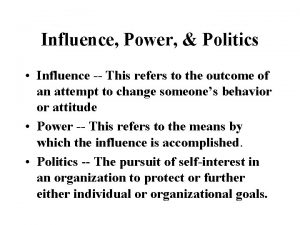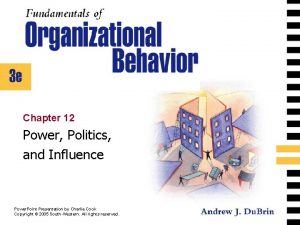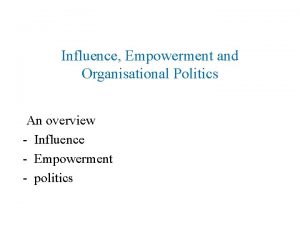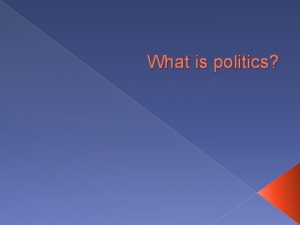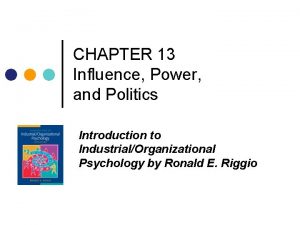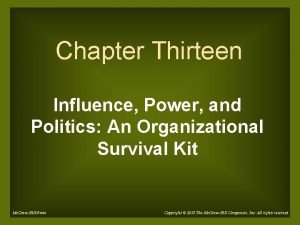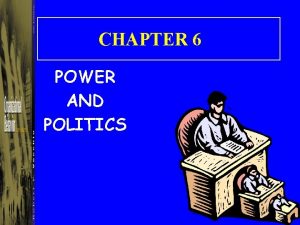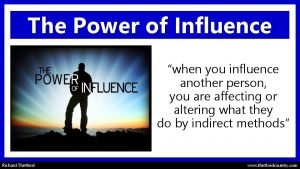Power Politics and Influence Chapter 11 Fundamentals of















- Slides: 15

Power, Politics, and Influence Chapter 11 Fundamentals of Organizational Behavior 2 e Andrew J. Du. Brin Power. Point Presentation by Charlie Cook

Learning Objectives Identify sources of power for individuals and subunits in organizations. Describe the essence of empowerment. Pinpoint factors contributing to organizational politics. Identify and describe a variety of political and influence tactics. Explain how managers can control dysfunctional politics. Differentiate between the ethical and unethical use of power, politics, and influence. A. J. Du. Brin, Fundamentals of Organizational Behavior, Second Edition. Copyright © 2002 by South-Western. 2

The Meaning of Power, Politics, and Influence Power v Is the potential or ability to influence decisions and control resources. Organizational politics v Is the informal approaches to gaining power through means other than merit or luck. Influence v Resembles power, but tends to be more subtle and indirect. A. J. Du. Brin, Fundamentals of Organizational Behavior, Second Edition. Copyright © 2002 by South-Western. 3

Sources of Individual and Subunit Power Socialized Power v Is the use of power to achieve constructive ends. Personalized Power v Is the use of power primarily for the sake of personal aggrandizement and gain. A. J. Du. Brin, Fundamentals of Organizational Behavior, Second Edition. Copyright © 2002 by South-Western. 4

Sources of Individual and Subunit Power Granted by the Organization (Position Power) v Legitimate power is based on the manager’s formal position within the hierarchy of the firm. u Power is enhanced by establishing polices and procedures that increase the scope of the position’s control. v Coercive power is controlling others through the fear of punishment. u To be effective, employees must fear the punishment. v Reward power is controlling others through rewards or the promise of rewards. A. J. Du. Brin, Fundamentals of Organizational Behavior, Second Edition. Copyright © 2002 by South-Western. 5

Sources of Individual and Subunit Power Stemming from the Individual (Personal Power) v Expert power is the ability to influence others because of one’s specialized knowledge, skills, or abilities. v Referent power is the ability to influence others that stems from one’s desirable traits and characteristics. A. J. Du. Brin, Fundamentals of Organizational Behavior, Second Edition. Copyright © 2002 by South-Western. 6

Sources of Individual and Subunit Power from Providing Resources v Resource Dependence Perspective u Subunits or individuals within an organization who control or provide the resources that the organization needs on a continuing basis can become quite powerful. u Control of resources equals power for managers. A. J. Du. Brin, Fundamentals of Organizational Behavior, Second Edition. Copyright © 2002 by South-Western. 7

Empowerment of Group Members Empowerment v Is the process of sharing power with group members, thereby enhancing their feelings of self -efficacy. v Strategic benefits of distributing power: u Improved productivity, quality, and satisfaction v Keys for the transition to effective empowerment: u Sharing information u Providing more structure (training and support) u Gradually replacing traditional organizational structure u Allowing individuals and teams to determine how to achieve objectives u Above all, trusting in employees to do the right thing A. J. Du. Brin, Fundamentals of Organizational Behavior, Second Edition. Copyright © 2002 by South-Western. 8

Five Stages in the Process of Empowerment Stage 1 Stage 2 Stage 3 Stage 4 Stage 5 Conditions leading to a psychological state of powerlessness The use of managerial strategies and techniques To provide selfefficacy information to subordinates, using four resources Results in empowering experience of subordinate Leading to behavioral effects Organizational factors Participative management Enactive attainment Supervision Goal setting Reward system Feedback system Vicarious experience Nature of job Modeling Contingent/ competencebased reward Job enrichment EXHIBIT 11 -1 Verbal persuasion Strengthening of effort— performance expectancy or belief in personal efficacy Initiation/ persistence of behavior to accomplish task objectives Emotional arousal and Remove conditions listed under Stage 1 Source: Jay A. Conger and Rabindra N. Kanungo, “The Empowerment Process: Integrating Theory and Practice, ” Academy of Management Review (July 1988): p. 475. A. J. Du. Brin, Fundamentals of Organizational Behavior, Second Edition. Copyright © 2002 by South-Western. 9

Signs of Empowerment and Disempowerment Empowered Employees v Take initiative in ambiguous situations v Identify opportunities in ambiguous situations v Apply critical thinking skills v Offer judgments about how decisions support shared purpose v Identify and act on opportunities to improve systems v Optimize resources by reducing expenses and finding opportunities to invest in new resources A. J. Du. Brin, Fundamentals of Organizational Behavior, Second Edition. Copyright © 2002 by South-Western. 10

Signs of Empowerment and Disempowerment Disempowered Employees v Wait for a designated authority to take charge v Address problem but fail to see opportunity v Accept decisions without questioning v Discuss but not able to apply information about shared purpose v Attempt consensus but yield to higher authority when failing at consensus v Focus on resource questions only when directed to do so A. J. Du. Brin, Fundamentals of Organizational Behavior, Second Edition. Copyright © 2002 by South-Western. 11

Factors Contributing To and Examples of Political Behavior Organizations have a political nature due to: v Coalitions of interests competing for resources. v A pyramidal power structure that concentrates power at the top of the organization. v Downsizing and team structures limit upward mobility for ambitious managers with a strong need for power. v Decentralization disperses power in the organization. v Machiavellian manipulation of others and the organization for personal gain by some managers. A. J. Du. Brin, Fundamentals of Organizational Behavior, Second Edition. Copyright © 2002 by South-Western. 12

Effective Use of Organizational Politics Ethical Behaviors Develop power contacts Manage your impression Control vital information Keep informed Be courteous, pleasant, and positive Ask satisfied customer to contact your manager Avoid political blunders Use flattery sincerely Unethical Behaviors 1. 2. 3. 4. Engage in backstabbing Embrace-or-demolish Set a person up for failure Play territorial games (turf wars) A. J. Du. Brin, Fundamentals of Organizational Behavior, Second Edition. Copyright © 2002 by South-Western. 13

Organizational Influence Tactics Leading by example Assertiveness Rationality Ingratiation Exchange Inspirational appeal and emotional display Joking and kidding A. J. Du. Brin, Fundamentals of Organizational Behavior, Second Edition. Copyright © 2002 by South-Western. 14

The Control of Dysfunctional Politics and Ethical Considerations Excessive politics and influence tactics can harm an organization and its members. Ways to control these activities: v Rely on objective measures of performance tied to proper and significant goals for the organization. v Align individual goals and objectives to be congruent with those of the organization to increase commitment and performance. v Practice open communications to remove the political value of information and to increase the overall understanding of the organization. A. J. Du. Brin, Fundamentals of Organizational Behavior, Second Edition. Copyright © 2002 by South-Western. 15
 Power and politics in organizations
Power and politics in organizations Power, politics and conflict in organizations
Power, politics and conflict in organizations Power, politics and conflict in organizations
Power, politics and conflict in organizations Contrasting leadership and power
Contrasting leadership and power Power and politics organization theory
Power and politics organization theory Power and politics
Power and politics The nature of power politics and government
The nature of power politics and government Power definition
Power definition Power traiangle
Power traiangle Stakeholder mapping template
Stakeholder mapping template Power and influence mapping
Power and influence mapping Influence map template
Influence map template Stakeholders matrix
Stakeholders matrix Power and influence in the workplace
Power and influence in the workplace Lesson 5 african american culture and politics
Lesson 5 african american culture and politics Chapter 31 the politics of boom and bust
Chapter 31 the politics of boom and bust
